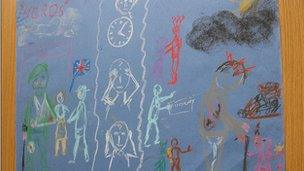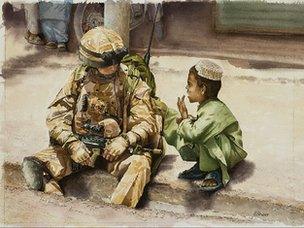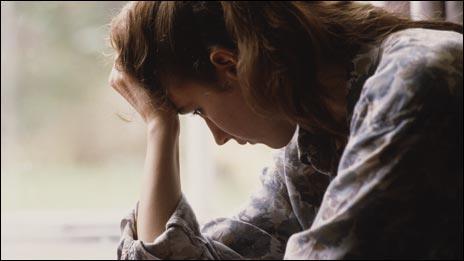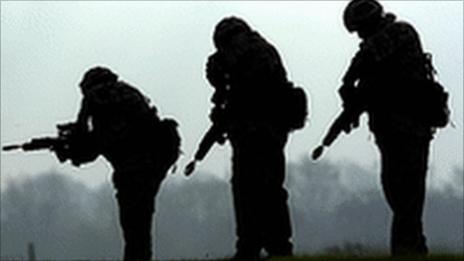Art: An unlikely form of army therapy
- Published
The BBC's Culture Show visited an art therapy session at Combat Stress to see how it is helping veterans
With the lack of military hospitals, many veterans are turning to charities for help. One is using the unlikely weapon of art to help fight the psychological wounds of war, while another organisation is actively encouraging artwork in the army.
Outside of the NHS, the charity Combat Stress is the biggest provider of support to armed forces veterans with conditions such as post-traumatic stress disorder (PTSD), depression and anxiety.
Art therapy is one of the treatments it uses. Drawing, sculpting and painting are helping patients manage their symptoms with great success.
"Traumatic memories take a different path from our normal memories and tend to be frozen in the body in the central nervous system," explains Janice Lobban, who has been a trauma therapist at Combat Stress for the past 10 years.
"When a trauma happens, the person will react to get through the experience, but it leaves the trauma unprocessed. A person might then get a sensory memory like a sound, or sight, or smell, that is reminiscent of the trauma and they re-experience it happening again."
'Blank mind'

Sessions begin with a quick creative session to get thoughts and images down on paper
Art therapy, therefore, aims to help people express themselves unconsciously and process the meaning afterwards.
Group sessions typically begin with the therapist giving a one or two word brief to inspire creativity before veterans are given a selection of materials for painting, modelling or writing.
After 45 minutes of quick work, the group then get together to talk about and describe what they've just created.
"I try to keep a blank mind and just let images and feelings rise out from my unconscious to my hand and things start appearing," says Richard Kidgell from Braintree, Essex, who served in the Royal Air Force from 1978 to 1985.
"What surprises me is that while I'm drawing I don't know what it is - they're just images, but by the end of the session I've made a complete story. It's quite enlightening as sometimes I'm not entirely sure what I've drawn until I speak to others about it."
After their sessions, the veterans are encouraged to develop their initial artwork into fuller, finished pieces to further interpret and explore their feelings.
Invisible wounds

Veteran Richard Kidgell with his finished artwork inspired by an art therapy session
Although many of the veterans who try the therapy may never have had any interest in art before, there are some servicemen who actively pursue the craft and use it to reflect their experiences.
The Army Arts Society, set up by war artist Linda Kitson after the Falklands War, promotes and supports arts and crafts within the British Army - working with serving military, those who have retired and even their dependants.
One of its latest initiatives is to provide operational art packs to troops - the first 20 of which went out to Afghanistan in September.
"Art is a way of keeping some people sane," says committee member Francesca Bex, herself a painter and the wife of a bomb disposal expert.
"The packs can give soldiers an alternative. A lot of them watch awful films when they have down time and art can give some a different option."
'Angry and frustrated'
Art has been invaluable for 32-year-old serviceman, Nick. Having joined the army when he was 16, he has been posted in countries including Germany, Kosovo and Afghanistan.
After qualifying as a diving supervisor for his regiment's airborne unit in Portsmouth, he was attacked while out one evening last May and left with serious head injuries.
In a coma for almost a month, he spent a lengthy time in a rehabilitation unit, where he had difficulty walking and talking, and suffered from hallucinations and memory loss.
"I was due to go on tour in September to Afghanistan but couldn't make it as I was in hospital. I felt guilty this had happened to me," he says.
"Eventually I got put back to my regiment and I tried to do my diving job but my head wasn't good enough to enable me to do it.
"I was quite angry and frustrated and, as a lot of the lads were away on tour or leave, I didn't have anyone to talk to. I thought I'd lost everything I loved."
It was while looking through regiment photos that Nick thought he would try his hand at painting - something he used to enjoy doing. A colleague's wife then suggested he join the Army Arts Society and he gained a new lease of life.
"I'd spend about 50 to 70 hours on a picture and every night, instead of sitting on the steps and questioning everything. I just worked on it and it was heaven," he says.
Even though he was not confident in his abilities, the society encouraged Nick to enter its Serving War Artist of the Year competition - which he went on to win for his watercolour, Deliberation.

Nick won the Serving War Artist of the Year award for his watercolour, Deliberation
Nick says art has been invaluable in giving him something to aim for again: "I was struggling trying to justify everything, but as soon as I get hold of a paintbrush it takes my mind off some really bad thoughts and focuses my mind on one thing."
He fully supports the operational art pack initiative. During his time in the army, he says there was no outlet for art - unlike the more traditional pastimes of rugby or football.
Richard Kidgell agrees it's a good idea to give soldiers the opportunity to process what they are experiencing on a tour of duty. Potentially, it can allow the military to spot the symptoms of PTSD early.
"My guess is a lot of the packs will be largely wasted as people will dabble for 10 minutes and think it's not for them," he says.
"But even for the minority who will grasp the idea, the benefits for catching those people at an early stage and giving them a chance to vent will be brilliant."
The Culture Show: Invisible Wounds is on BBC Two and BBC HD on Friday 11 November at 19:00GMT.
- Published10 October 2011

- Published6 June 2011
